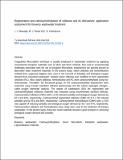| dc.contributor.author | Mwesiga, J. J. | |
| dc.contributor.author | Rwiza, Mwemezi | |
| dc.contributor.author | Kalmykova, E. N. | |
| dc.date.accessioned | 2021-02-23T05:42:42Z | |
| dc.date.available | 2021-02-23T05:42:42Z | |
| dc.date.issued | 2021-02-13 | |
| dc.identifier.uri | https://doi.org/10.1007/s13762-021-03190-9 | |
| dc.identifier.uri | https://dspace.nm-aist.ac.tz/handle/20.500.12479/1126 | |
| dc.description | This research article published by Springer Nature Switzerland AG., 2021 | en_US |
| dc.description.abstract | Coagulation–flocculation technique is usually employed in wastewater treatment by applying conventional inorganic materials such as alum and ferric chloride. Due cost to environmental challenges associated with the use of inorganic flocculants, biopolymers are gaining ground as alternative water treatment materials. In the present study, native cellulose and hemicelluloses isolated from sugarcane bagasse were used in the removal of turbidity and biological oxygen demand from industrial wastewater. Isolated native cellulose was modified to form regenerated cellulose (RC). Also, native cellulose, hemicellulose and RC were carboxymethylated using Na-chloroacetate. Thereafter, the functional groups on the carboxymethylated biopolymers were examined using Fourier transform infrared spectroscopy and the carbon–hydrogen–nitrogen–sulfur–oxygen elemental analysis. The degree of substitution (DS) for regenerated and carboxymethylated cellulosic materials was measured using recommended standard methods. Carboxymethyl cellulose (CMC) with 1.3 DS reduced turbidity and biological oxygen demand by 62.2 and 64%, respectively. Carboxymethyl regenerated cellulose (CMC-II) at 1.1 DS reduced turbidity and by 55.6 and 60%, respectively. Carboxymethyl hemicellulose (CMH) with 1.4 DS was capable of reducing turbidity and biological oxygen demand by 45.7 and 47%, respectively. Carboxymethyl cellulose and hemicellulose have rarely been used in the treatment of brewery wastewater. In the present study, these two novel materials showed a good prospect in removing biological oxygen demand and turbidity. | en_US |
| dc.language.iso | en | en_US |
| dc.publisher | Springer Nature Switzerland AG. | en_US |
| dc.subject | Brewery wastewater | en_US |
| dc.subject | Carboxymethylation | en_US |
| dc.subject | Green flocculants | en_US |
| dc.subject | Industrial wastewater | en_US |
| dc.subject | Lignocellulosic materials | en_US |
| dc.title | Regeneration and carboxymethylation of cellulose and its derivatives: application assessment for brewery wastewater treatment | en_US |
| dc.type | Article | en_US |

